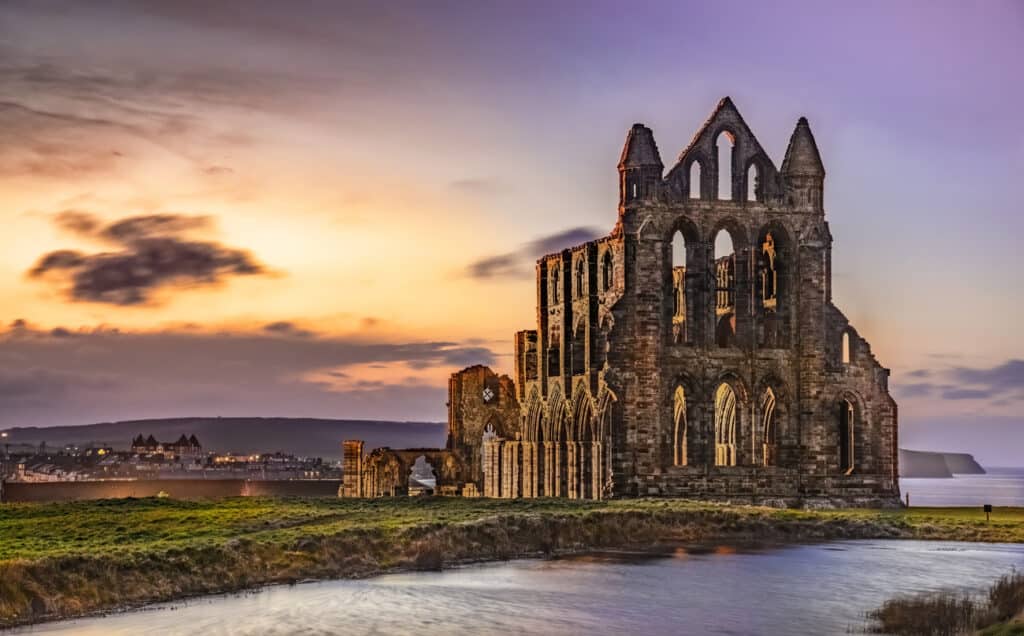Whitby: Where Gothic Romance Meets Coastal Charm
Perched dramatically on the North Yorkshire coast, where the River Esk meets the North Sea, lies Whitby – a town unlike any other. With its windswept abbey ruins, cobbled streets, bustling harbour, and a distinct air of gothic mystery, Whitby captivates the imagination and leaves an indelible mark on all who visit. It’s a place where ancient history, maritime adventure, and literary legend intertwine, promising a truly unique escape.
The Haunting Beauty of Whitby Abbey
Dominating the East Cliff, the imposing ruins of Whitby Abbey are the town’s most iconic landmark and a testament to centuries of history. Founded in 657 AD, this once-grand Benedictine monastery played a pivotal role in early English Christianity. Though now a magnificent skeleton against the sky, its gothic arches and crumbling walls evoke a powerful sense of awe and melancholic beauty.
It’s no surprise that this atmospheric setting inspired Bram Stoker for parts of his iconic novel, Dracula. Imagine the eerie arrival of the Demeter, carrying its chilling cargo, shipwrecked on Tate Hill Sands below, and the monstrous dog bounding up the famous 199 Steps to the abbey’s graveyard. Exploring the Abbey, managed by English Heritage, offers breathtaking panoramic views of the town, the harbour, and the vast expanse of the North Sea.
The 199 Steps and St. Mary’s Church
Leading directly from the bustling town up to the Abbey are the legendary 199 Steps. It’s a steep climb, but every step offers a more expansive view, revealing the red rooftops of the old town, the winding river, and the busy port. At the top, nestled beside the Abbey, stands the ancient Church of St. Mary.
This mediaeval parish church is a fascinating time capsule, with its higgledy-piggledy box pews, triple-decker pulpit, and a wonderfully quirky interior. The churchyard, with its weather-beaten gravestones leaning precariously on the cliff edge, further cements Whitby’s gothic allure and its direct connection to Stoker’s Dracula – several names from the gravestones are said to have found their way into the novel.
Maritime Legends: Captain Cook and The Endeavour
Beyond its gothic connections, Whitby boasts a proud and rich maritime heritage. It was here that the legendary explorer Captain James Cook learnt his trade, serving his apprenticeship in the town. Whitby-built colliers, sturdy ships known for their robust design, were later adapted by Cook for his epic voyages of discovery, including the famous HMS Endeavour.
You can delve deeper into his story at the Captain Cook Memorial Museum, housed in the very building where Cook lodged as an apprentice. The museum offers a fascinating insight into his life, his remarkable voyages, and the incredible achievements of his crews. A statue of Captain Cook also stands proudly on the West Cliff, gazing out to sea, a fitting tribute to Whitby’s most famous son.

Whitby Jet: A Unique Souvenir
As you wander through Whitby’s narrow, winding streets, particularly on the historic East Side, you’ll notice numerous shops adorned with gleaming black jewellery. This is Whitby Jet, a beautiful and unique gemstone found along this stretch of coastline. Formed over millions of years from fossilised wood, Whitby Jet became incredibly popular during the Victorian era, especially for mourning jewellery after Queen Victoria herself wore it following the death of Prince Albert.
Today, skilled artisans continue to craft stunning pieces, from traditional Victorian designs to contemporary creations. Visiting a Whitby Jet shop is an experience in itself, with many offering insights into the stone’s fascinating geological history and the craftsmanship involved. It makes for a truly authentic and meaningful souvenir of your visit.
A Feast for the Senses: Fish & Chips and More
No trip to Whitby is complete without indulging in its culinary delights, most notably its world-famous fish and chips. The town is awash with fantastic chippies, each vying for the title of “best in Whitby.” From traditional takeaways where you can enjoy your meal wrapped in paper by the harbour, to bustling restaurants with sea views, the fresh, perfectly battered fish and golden chips are an absolute must-try. Places like Hadley’s and Mister Chips are consistently highly rated.
Beyond fish and chips, Whitby offers a diverse range of eateries, from traditional pubs serving hearty meals to charming cafés and contemporary restaurants. Explore the independent shops for local delicacies, baked goods, and unique crafts. The working harbour itself is a constant source of activity, with fishing boats coming and going, adding to the authentic seaside atmosphere. Take a stroll along the piers, watch the boats, or even embark on a boat trip yourself for a different perspective of the coastline.
Planning Your Whitby Adventure
Whitby is wonderfully walkable, though be prepared for hills and cobbled streets! The town is divided by the River Esk, connected by a swing bridge that opens regularly to allow boats through – a charming spectacle in itself.
Parking in Whitby can be challenging, especially during peak season. Several pay-and-display car parks are available (such as Abbey Headland and West Cliff), and a convenient Park & Ride service operates from the outskirts of town, highly recommended for a stress-free arrival.
The best time to visit Whitby largely depends on your preference. The summer months (June to August) offer the warmest weather and a lively atmosphere, though it can get very busy. Late spring and early autumn (April-May, September-October) are often ideal, with milder weather and fewer crowds. If you’re a fan of all things gothic, the Whitby Goth Weekend, held twice a year (usually in April and October), transforms the town into a truly unique spectacle of Victorian and alternative fashion.
Whitby is more than just a seaside town; it’s an experience. It’s a place that stirs the soul, ignites the imagination, and offers a perfect blend of dramatic history, coastal beauty, and genuine character.

